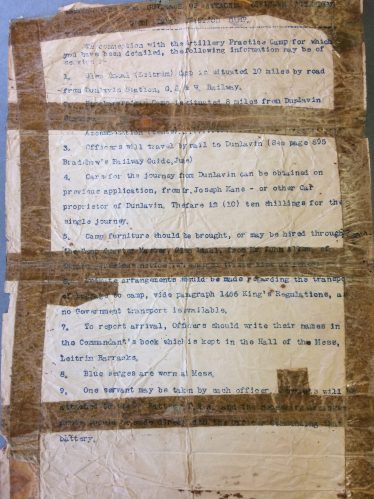Rules for Imaal Camp




Instructions for guidance of attached officers attending Glen Imaal practice camp
While researching the history of the village of Knockanarrigan, I spent some time in the National Library of Ireland. The task was to find and read anything with a reference to the Glen of Imaal. Using the online catalogue of the National Library I ordered a file which contained information which might be of use. Several days later the research was made available to me in no. 2 Kildare street. A folder was brought to my table and the following was its contents. It was a very old and a barely held together piece of paper with a list of details for attending a summer practice camp at Leitrim barracks at the turn of the last century. I found it interesting in the way times have changed and says so much of the privilege afforded to officers in the British army in the past.
The following is a transcript of that list.
In connection with the artillery practice camp for which you have been detailed, the following information may be of service.
- Glen Imaal (Leitrim) Camp is situated 10 miles by road from Dunlavin Station, G.S.& W. railway.
- Knockanarrigan Camp is situated 8 miles from Dunlavin Station. Accommodation (tents) Leitrim.
- Officers will travel by rail to Dunlavin ( see page 895 Bradshaws Railway guide, June).
- Cars for the journey from Dunlavin can be obtained on previous application, from Mr. Joseph Kane – or other car proprietor of Dunlavin. The fare is (10) ten shillings for the single journey.
- Camp furniture should be brought, or may be hired through the Camp Quarter master, glen Imaal, from Mr. John Allen, of Donard, previous notice is required.
- Private arrangements should be made regarding the transport of baggage to camp, vide paragraph 1466 kings regulations, no government transport is available.
- To report arrival, Officers should write their names in the Commandant’s book which is kept in the Hall of the mess Leitrim Barracks.
- Blue serges are worn at mess.
- One servant may be taken by each officer. Servants will be attached to the 31st Battery R.F.A. and the necessary arrangements should be made direct with the officer commanding this battery.
Notes on the Transcript.
The value of 10 shillings translates in today’s money as approx. €11.00.
The blue serge outfit worn at mess, refers to the uniform required in the mess as this was the official officer space. It was important for the officer to know the dress code for each camp to be aligned with his colleagues.
R.F.A. refers to the Royal Field Artillery. This branch of the British army provided medium artillery and was the largest arm of the army. Working alongside the field artillery was the the Royal Horse Artillery, created to provide support, as horses pulled large guns and canons and all the supplies needed at that time.




No Comments
Add a comment about this page